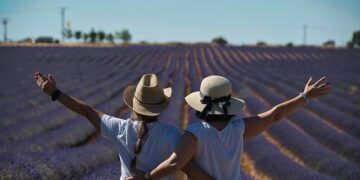In a remarkable display of resilience and dedication to health, communities across China are embracing an unconventional winter tradition: swimming in freezing rivers. As temperatures plummet, participants gather along the banks of these icy bodies of water, often donning little more than swimsuits, to plunge into the frigid depths. This unique practice, steeped in cultural significance and a commitment to well-being, has garnered attention not only for its physical benefits but also for its role in fostering camaraderie and boosting mental health. As reported by Voice of America, millions are turning to this chilling ritual, underscoring the lengths to which individuals will go in the pursuit of happiness and vitality, even in the harshest of climates.
People Embrace Cold Water Therapy for Physical Wellness and Mental Resilience
The practice of immersing oneself in icy waters is gaining momentum in China, where individuals are turning to frigid river swims as a remedy for both physical ailments and mental fortitude. Proponents of this invigorating ritual believe that the shock of cold water enhances circulation, bolsters the immune system, and alleviates chronic pain. Participants often report feeling a profound sense of clarity and energy after their swims, attributing this to the invigorating rush of adrenaline that accompanies the cold exposure. Additionally, the practice serves as a community-building exercise, fostering connections among those who seek to push their limits together.
Cold water therapy is not just a fleeting trend; it has become a part of a larger wellness movement focused on holistic health. Many adherents incorporate this practice into their routine alongside other elements of well-being, such as meditation and breathwork. A few key benefits highlighted by advocates include:
- Improved Mood: Exposure to cold water is said to enhance mood by stimulating the release of endorphins.
- Increased Resilience: Regularly facing the discomfort of cold water can foster mental toughness and resilience.
- Fostering Community: Group swims encourage social interaction and collective motivation.
With the practice becoming increasingly popular, some local governments are even establishing designated areas for cold water therapy, promoting it as a natural and accessible route to wellness. The balance between individual challenge and shared experience underlines the growing recognition of cold water therapy as a viable trend for improving quality of life among diverse populations.
Exploring the Cultural Significance of Winter Swimming in Chinese Communities
The practice of winter swimming holds deep cultural roots within various Chinese communities, intertwining physical prowess with traditional beliefs in wellness and resilience. For many participants, the icy waters symbolize a rite of passage, fostering not just individual strength but also a profound sense of community. Beachfront gatherings become social events where swimmers exchange stories of personal challenges and triumphs, reinforcing bonds that extend beyond the water. This communal experience echoes elements of yangsheng, or nurturing life, a philosophy that promotes harmony with nature through practices that enhance both physical and mental health.
Historically, winter swimming has been associated with Taoist and Chinese medicinal principles, advocating for exposure to cold as a means to boost immunity and enhance vitality. Enthusiasts argue that the invigorating swim not only invigorates the body but also clears the mind, promoting a meditative state that enriches their overall sense of well-being. Participants often cite numerous benefits, including:
- Increased stamina: Engaging in such extreme conditions fosters a stronger constitution.
- Stress relief: The shock of cold water serves as a natural stress reliever.
- Social connectivity: Shared experiences in challenging environments strengthen community ties.
Ultimately, winter swimming transcends being merely a check on physical strength; it resonates with age-old philosophical traditions, making significant contributions to the cultural tapestry of China. Through the lens of this practice, many discover a deeper connection with nature, themselves, and their communities, reflecting a profound understanding of the balance between body and mind.
Expert Insights: Health Benefits and Safety Tips for Swimming in Freezing Waters
Swimming in frigid waters has garnered attention for its purported health benefits. Enthusiasts claim that regular exposure to cold water can enhance circulation, boost the immune system, and improve mental resilience. Studies suggest that immersing oneself in chilly environments stimulates endorphin release, leading to improved mood and reduced anxiety levels. Proponents assert that this invigorating practice can contribute to a sense of happiness and well-being, often leading to a dedicated community of cold-water swimmers who share tips and experiences. Notably, many participants in these activities point to increased levels of energy and a stronger connection to nature, which can be especially rewarding in a fast-paced world.
However, there are essential safety considerations to keep in mind for those tempted to take the plunge. Proper preparation and understanding of one’s physical limits are crucial. Participants are encouraged to follow these essential guidelines:
- Acclimatization: Gradually introduce your body to colder temperatures to avoid shock.
- Buddy System: Always swim with a partner to ensure safety and immediate assistance if needed.
- Duration Control: Limit exposure to 10-15 minutes, especially for beginners.
- Weather Awareness: Monitor environmental conditions and avoid swimming during extreme cold or severe weather.
Additionally, it’s vital to recognize early signs of hypothermia, such as shivering, disorientation, and fatigue. Those considering this invigorating practice should consult with a healthcare professional to assess their ability to undertake such an activity safely.
Concluding Remarks
In conclusion, the practice of swimming in the freezing waters of China’s rivers is more than just a daring adventure; it embodies a cultural commitment to health and well-being. With participants citing benefits ranging from enhanced physical fitness to improved mental clarity and a profound sense of community, this remarkable phenomenon showcases the enduring human spirit even in the harshest of conditions. As winter envelops the landscape, these brave swimmers continue to defy the cold, reminding us that resilience and joy can often be found in the most unlikely places. VOA will continue to follow this story and provide updates on the evolving relationship between traditional practices and modern health perspectives in China.














Italy to Deport Egyptian Imam After Controversial Comments at Pro-Palestine Rally